Imagine waking up to the sounds of nature, seeing amazing sights and experiencing an incredible biodiversity of species of both plant and animal life. Students who were part of the Costa Rica Natural History study abroad trip over Spring Break 2023 don’t have to imagine it; they lived it.
biodiversity of species of both plant and animal life. Students who were part of the Costa Rica Natural History study abroad trip over Spring Break 2023 don’t have to imagine it; they lived it.
The Costa Rica Natural History study abroad trip offers students the opportunity to explore biodiversity and Costa Rican societal values in tropical rainforest, Pacific dry forest, Pacific rock reef and Pacific mangrove ecosystems.
The 10-day excursion includes birding, boat trips and hiking, while exposing students to sustainable management of tourism, conservation in Costa Rica, and hands-on experiences in wildlife and aquatic sciences.
“Costa Rica has so much beauty to it that it is often hard to choose what speaks to you the most,” said senior wildlife major Phoebe Soldi, who acted as a teaching assistant on the trip in 2023 after traveling as a student in 2022. “The trees and the wildlife always speak to me because I have always loved spending time outdoors, especially within new places with such different flora and fauna. However, I have to say that the people are always the most influential parts of the trip. Our tour guides Carlos and Jose and their eagerness to share their customs and culture make it so easy to fall in love with the differences between our country and theirs. Because I met these people last year, it was amazing to catch up with all those I had the pleasure in meeting for the second time because I got to know them on more of a personal level.”
 Images of the people involved in the 2023 Costa Rica Study Abroad trip - students, faculty and guides
Images of the people involved in the 2023 Costa Rica Study Abroad trip - students, faculty and guides The trip enabled sophomore wildlife major Leah Griffin to be immersed in the Spanish culture and utilize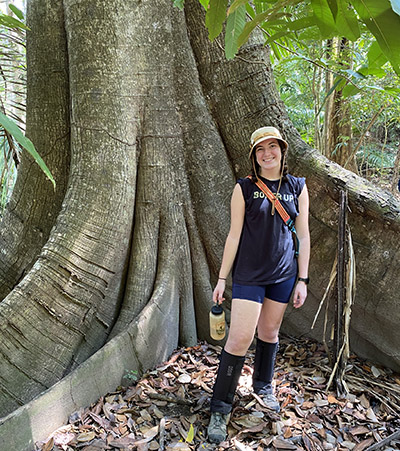 her language skills.
her language skills.
“I have been studying Spanish since I was 14 (and I am a Spanish minor) but I had never used it in a setting outside of the classroom before this trip,” Griffin said. “Experiencing language in a new way was wonderful because it allowed me to get to know my hosts at La Suerte on a more personal level as I chatted with them during down time.”
For senior aquatic sciences major Kirsten Adams the trip was full of new experiences from the time it began.
“I had never traveled internationally before, so even things as small as getting served a meal on the flight were new experiences for me,” Adams said. “Hiking in the rainforest, seeing a pineapple farm, learning how chocolate is made, seeing bioluminescent algae, snorkeling and being able to reach out and touch the fish, and, of course, all the tropical wildlife were all new experiences for me that I'll hold onto forever.”
The diversity of the habitats and the variety of species that the group was able to encounter made an impact on senior aquatic sciences major Brynna Buckmaster.
“Everything was a new experience! I had never been in a tropical rainforest or a tropical dry forest, so getting to experience both by simply crossing the continental divide in Costa Rica was amazing,” Buckmaster said. “I saw over 200 new species while in Costa Rica, which is more than I have ever seen in a week before. In La Fortuna, we were surrounded by active volcanoes and even got to experience the hot springs that the volcanoes make.
“I was most impressed by the quantity of species we saw. I have never seen that many bird species before and known what they are. (Thanks to Dr. Dunning or our guide Carlos for telling us what they were). We didn’t see many mammals, but we got to see white-faced capuchin monkeys and coatimundis up close and watch them eat and run around. The fish that we got to see while snorkeling were dazzling and schooling around us, so we could see them right next to us.”
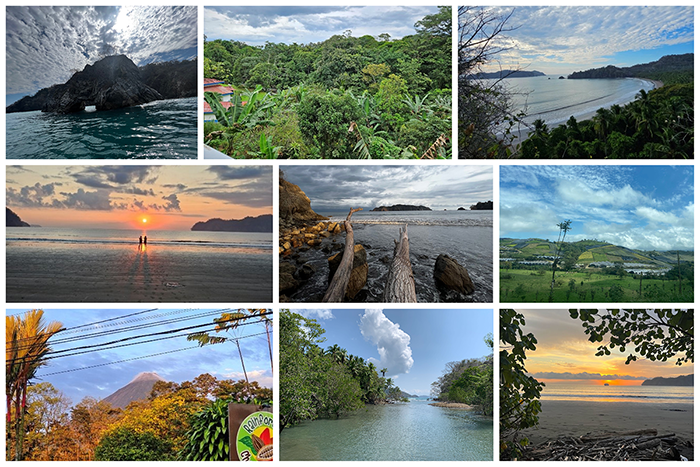 Images of the various landscapes the group encountered in Costa Rica from tropical rainforest to Pacific dry forest, Pacific rock reef and Pacific mangrove ecosystems.
Images of the various landscapes the group encountered in Costa Rica from tropical rainforest to Pacific dry forest, Pacific rock reef and Pacific mangrove ecosystems. The biodiversity the group encountered also made an impression on senior wildlife major Gretchen Weliever.
“I saw hundreds of new species including plants, birds, mammals, reptiles, amphibians, and insects,”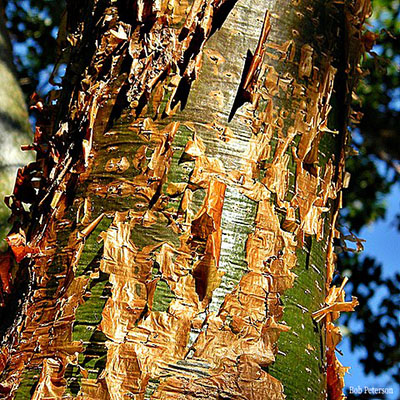 Weliever said. “The biodiversity of the plant life was amazing! One of my favorite aspects was a tree we saw at Curú Wildlife Refuge. We learned about the tourist tree (Bursera simaruba) and how it sloughs off a paper-thin layer of bark when epiphytes try to grow up into the tree. It also does some photosynthesis through its trunk, so the base of the tree is a beautiful green color!”
Weliever said. “The biodiversity of the plant life was amazing! One of my favorite aspects was a tree we saw at Curú Wildlife Refuge. We learned about the tourist tree (Bursera simaruba) and how it sloughs off a paper-thin layer of bark when epiphytes try to grow up into the tree. It also does some photosynthesis through its trunk, so the base of the tree is a beautiful green color!”
The trees, including the tourist tree, also stuck out to Griffin.
“I was most impressed with the unique adaptations that certain tree species had to be successful,” Griffin said. “In forest settings, finding sunlight and reaching the canopy is vital to thrive. The tourist tree has a red paper-like film that easily peels to reveal green bark underneath. The papery film prevents vines from growing up the tree and choking it out; the green bark allows the tree to photosynthesize during the dry season. Many trees in the tropical dry forest, including the tourist tree, drop their leaves during the dry season because of environmental stress.
“My favorite species to see was probably the Turquoise-browed Motmot. I was even able to snap a photo with two of them in a tree when we were at Curú! They have very unique tail feathers.”
Even those who have experienced Costa Rica before are not immune from being awestruck by the biodiversity they encounter.
“Because I attended for the second time, it was amazing how much more I was able to focus on the wildlife and biodiversity,” Soldi shared. “The first trip I was experiencing wonderful yet drastic culture shock, which took up much of my focus of the trip. However, this year I was able to really identify the drastic differences in our biota and recognize which geographical features caused these differences. I really gained an appreciation for the large diversity of birds found in Costa Rica on this trip, including some charismatic birds that we got to see like the Turquoise-browed Motmots and the Golden-hooded Tanager (two of my favorites from the trip).”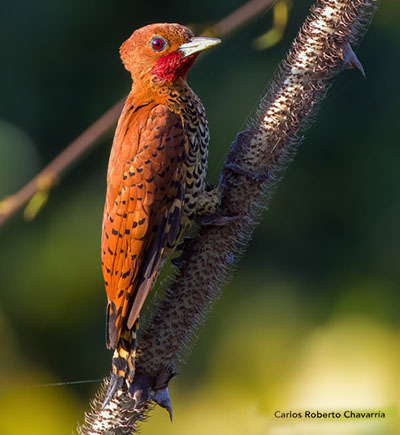
Dr. Barny Dunning, who was leading the study abroad trip for the eighth time, was even able to add to his life list of bird species that he has seen.
“I have recorded about 475 species of birds in Costa Rica, but I am still able to see new things on each trip," Dunning said. "In part this is because our host, Carlos Chavarria, plans each trip so that we are going to new places each year. On this year’s trip, we saw a Cinnamon Woodpecker on the first day right at the beginning of the first bird walk. That was a “lifer” for me and is a spectacularly colored bird. While in the northern part of the country, we saw a Jabiru, a native stork which has been one of my “most wanted” species. Later on in the trip, we made a brief stop along the Pacific coast to allow our host to search for three species of rare gulls that had been reported in the area. We found one of the three, which was very exciting for Carlos. Ironically, the species was a Ring-billed Gull which is the most common gull we see in Indiana.”
Adams was impacted by the birding experiences with Dunning in a variety of ways. 
“I think one of my favorite moments from the trip was seeing how excited Dr. Dunning got when he saw a new bird to add to his life list,” Adams said. “Of course, he is the bird god, so getting to see him see new birds for the first time even got a fish kid excited to go birding at 6 a.m. every morning. I think the biggest "holy cow" moment for me when it comes to the biodiversity was the first morning of birding. Before we had even stepped off of the porch of the biological station we were staying at, we saw no less than 20 bird species flying around the trees nearby. Every moment a new one would get pointed out. Birding was a pretty brand-new thing for me, so everything was so brightly colored and new. My favorite species was probably the Turquoise-browed Motmot. I wish I could say it was a fish, but this bird was absolutely unreal.”
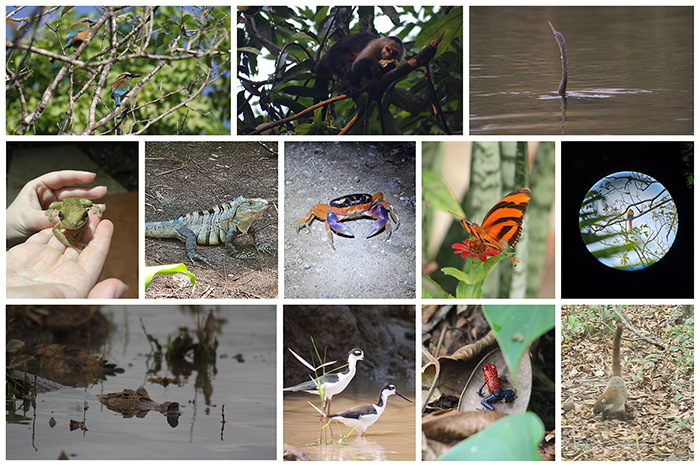 Images of a small sampling of species the group encountered, including: a turquoise-browed Motmot, a capuchin white-faced monkey, an Anhinga at Caño Negro popping its head back up after a dive for food, a veined tree frog, a Halloween crab, the banded orange heliconian butterfly, a Scarlet Macaw, a caiman crocodile, a Black-necked stilt, a strawberry poison dart frog and a coatimundi.
Images of a small sampling of species the group encountered, including: a turquoise-browed Motmot, a capuchin white-faced monkey, an Anhinga at Caño Negro popping its head back up after a dive for food, a veined tree frog, a Halloween crab, the banded orange heliconian butterfly, a Scarlet Macaw, a caiman crocodile, a Black-necked stilt, a strawberry poison dart frog and a coatimundi. Since the group did not stay in traditional hotels, students were able to observe the local environment at all hours. Lodging for the first three nights of the trip was at La Suerte Rainforest Field Station, followed by two nights at Cabinas La Catarata near the town of La Fortuna and three nights at Curú National Wildlife Refuge.
“My favorite memory was when we woke up every morning to dozens of different birds calling in the forest,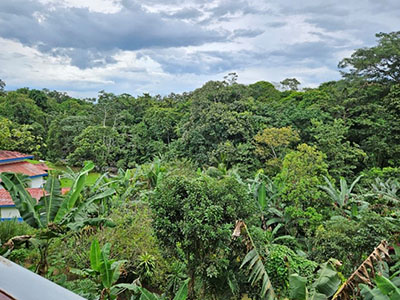 and howler monkeys vocalizing,” Weliever shared. “I was truly immersed in the culture and beauty of Costa Rica, and it was a trip I will never forget.”
and howler monkeys vocalizing,” Weliever shared. “I was truly immersed in the culture and beauty of Costa Rica, and it was a trip I will never forget.”
Students also were able to have the unique experience of a bioluminescent boat tour at Curú National Wildlife Refuge.
“One of the most drastically different experiences that I got to be a part of was the optional bioluminescent boat tour within Curú National Wildlife Refuge,” Soldi said of the 2023 trip. “The entire class opted into the activity, so we all piled into a boat and left close to sunset to go to a beach. We waited there until we went to the same place we went snorkeling earlier in the day. Once you get into the water and swim, it looks like small green sparks are coming off your own personal wake. Once my eyes adjusted and it got later in the night, the sparks got brighter and it was such an amazing experience. The entire boat ride home, our captain was driving the boat in a way that allowed us to watch the sparks emit from the boat wake. Overall, it was an amazing experience that I hope to experience again one day.”
Griffin and Buckmaster agreed that the bioluminescent swimming and snorkeling was unforgettable.
“I can’t pick a true favorite moment but one of the most memorable moments of the Costa Rica trip was when we went night snorkeling at Curú and got to swim in water with bioluminescence,” Griffin recalled. “We first noticed the water lighting up as the boat agitated the water and left a streak of light in its wake. When we jumped in, there were small and short bursts of light as I kicked my legs to tread water.”
“The bioluminescence tour felt magical,” Buckmaster added. “You would spin and just light up in the water, and it was so cool to be able to experience the ocean at night.”
The bioluminescent snorkeling allowed Weliever to encounter her favorite species from the trip.
“My favorite animal we saw was the spotted eagle ray,” Weliever said. “It swam right in front of me when we went snorkeling at night to see the bioluminescence and it was beautiful. It scared the lights out of me because it came out of nowhere, but it was an amazing experience.”
 Images of the Costa Rica study abroad group in various settings and on excursions from snorkeling to birdwatching to visit a cocoa farm and sampling chocolate.
Images of the Costa Rica study abroad group in various settings and on excursions from snorkeling to birdwatching to visit a cocoa farm and sampling chocolate. 




